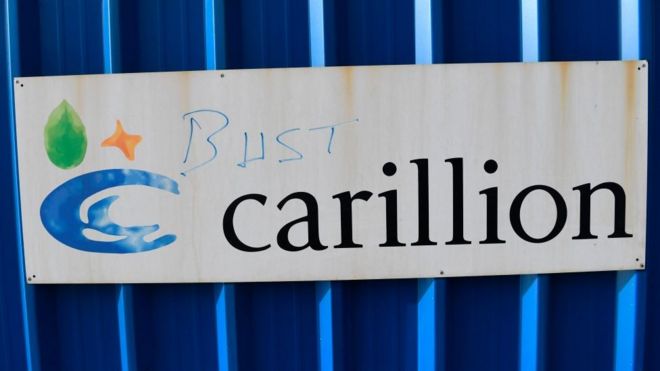Carillion: The signals that the company was going bust Carillion's collapse was for many people a bolt from the blue - a large UK▸ company that had no obvious problems went bust in a little more than a year.
Carillion's collapse was for many people a bolt from the blue - a large UK▸ company that had no obvious problems went bust in a little more than a year.Even the company's directors seemed to have no idea what was about to happen. In the annual report published in March, they signed off a "viability" statement saying there was no reason to think the company would have financial difficulties in the next three years.
Outside the company, however, there was widespread scepticism.
Investors had begun betting against Carillion shares as long ago as 2013.
Six months ago, at the height of the City scepticism, one quarter of all the company's shares were being used in "short" trades, an unheard of proportion for a large quoted company.
One hedge fund manager complained at the time that the trade had become so popular that it was no longer worth doing - the cost of borrowing Carillion shares, normally the necessary precursor to placing a short trade, had become prohibitive.
What did the short-sellers see that the company's board could not? Here are four of the tell-tale signs that (with hindsight) gave hedge funds and others sufficient confidence to bet that the company's shares would fall.
It's too good to be trueCarillion reported average margins of about 4%, twice the normal going rate for construction companies.
While some of this could be explained by the company's mix of business, with potentially lucrative service contracts and high-margin work in the Middle East, it seemed suspiciously high to some investors.
And high-margin work is good, as long as you actually receive payment. Industry insiders say Carillion was owed about £400m from Middle East contracts when it went under.
Longer payment termsConstruction industry veterans know that when main contractors come under pressure, their first port of call is making subcontractors wait for their money.
Late payment is endemic in construction, but Carillion was making its suppliers wait 120 days.
There was other evidence too; stories in the trade press about the woes of angry subcontractors, which enough to give keen-eyed hedge funds reason to think that cash was tight at Carillion.
Debts may have been larger than most thoughtCarillion had plenty of debt - about £850m at the time of its last annual report - although this had grown much larger by the time of its demise.
But that figure did not give a full picture. To help speed payment to its subcontractors, Carillion, in common with other large contractors, used a system called the Early Payment Facility.
Its suppliers could take their invoice to one of Carillion's lenders and be paid. The bank took a fee, and Carillion no longer owed the subcontractor, but the bank.
This sum was not included in the published debt figure, but was in the accounts under a different heading - if you knew where to look.
A new regime comingAll companies that have long-term contracts have to wrestle with the tricky question of when the profits should be recognised in the accounts.
If they abide by the actual flow of cash from the deals, then the results would be very lumpy, with big losses early on followed, hopefully, by profits in the final years.
Accounting rules allow companies to smooth the profits out, but it is a matter of judgement. If the judgement is too optimistic, profits can be booked too early.
The accounting rules are changing, with a new standard (IFRS 15) coming into force this year. It will force companies to be tougher, matching reported profits much more closely to actual cash flows.
It is not an unreasonable assumption for a hedge fund that the new accounting standard would be likely to hit Carillion's reported profitability.
It is worth remembering that the investors were betting only that the share price would fall.
Most probably expected that - as had happened with Carillion's big rival Balfour Beatty a few years earlier - there would be a string of profits warnings, a share price plunge, painful write-offs and a slow crawl back to normality.
It turned out to be much worse than that. As the interim chief executive Keith Cochrane set out in his witness statement to the court that approved the liquidation, the company had nearly no cash left at all.
The court requires a deposit to be paid to secure the liquidator's services; Carillion did not have it, relying instead on the government to come up with the sum.
The Financial Conduct Authority keeps a record of short positions in companies listed on the London Stock Exchange. Bear in mind that while the short sellers turned out to be right about Carillion, they have been wrong many other times.
And a short position may be just one part of a wider trading strategy - the table does not tell you anything about the reasons for the trades, or the wider context.





